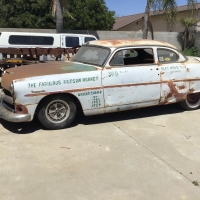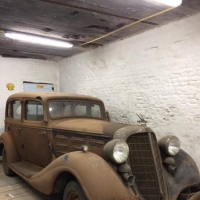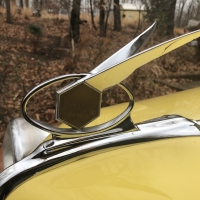Installing Oil Pan Gaskets
Old Fogey UK
Expert Adviser
in HUDSON
Here's a tip that worked for me -
New pan gaskets don't lie flat where you want them to and it's difficult to line up the holes, so do the job in stages.
Starting with the lower pan, apply a smear of gasket cement with your finger around half the pan.
Lower the first gasket onto that half, lining up the holes and press down firmly, applying weights to hold the gasket down.
When the cement sets, do the same with the other half.
When totally dry, smear cement right around the top surface of the gasket and drop the drip tray on top, aligning the holes, pressing down firmly.
After that has dried, do the same with the second gasket as with the first, fixing it one half at a time.
When everything is completely set, make sure all holes are clear and trim them if not - you don't want to find out the holes in the gaskets are misaligned after you've filled the oil troughs and are offering up the assembly because it's happened to me twice with ROC pan gaskets.
When you're ready for final assembly, put a smear of cement on the engine block, not the upper gasket.
Get a friend to help you offer up the pan using the 4 long bolts method ( not your spouse/partner who'll take offence and retreat into the house when the swearing starts as you start to raise the oil filled assembly and the oil slops around - like Mrs Fogey did ! ).
If you have one of those big oil syringes, when the gap is still a couple of inches, go around the gap squirting in oil to fill the troughs and wipe any drips off the gasket with brake cleaner - it's much easier than trying to lift the pan up with the troughs filled.
Then take the pan right up and insert the short bolts and then remove the long bolts and replace with the remaining short ones.
Job done !
It's not the quickest way of doing it but it minimises the risks of getting into a mess.
New pan gaskets don't lie flat where you want them to and it's difficult to line up the holes, so do the job in stages.
Starting with the lower pan, apply a smear of gasket cement with your finger around half the pan.
Lower the first gasket onto that half, lining up the holes and press down firmly, applying weights to hold the gasket down.
When the cement sets, do the same with the other half.
When totally dry, smear cement right around the top surface of the gasket and drop the drip tray on top, aligning the holes, pressing down firmly.
After that has dried, do the same with the second gasket as with the first, fixing it one half at a time.
When everything is completely set, make sure all holes are clear and trim them if not - you don't want to find out the holes in the gaskets are misaligned after you've filled the oil troughs and are offering up the assembly because it's happened to me twice with ROC pan gaskets.
When you're ready for final assembly, put a smear of cement on the engine block, not the upper gasket.
Get a friend to help you offer up the pan using the 4 long bolts method ( not your spouse/partner who'll take offence and retreat into the house when the swearing starts as you start to raise the oil filled assembly and the oil slops around - like Mrs Fogey did ! ).
If you have one of those big oil syringes, when the gap is still a couple of inches, go around the gap squirting in oil to fill the troughs and wipe any drips off the gasket with brake cleaner - it's much easier than trying to lift the pan up with the troughs filled.
Then take the pan right up and insert the short bolts and then remove the long bolts and replace with the remaining short ones.
Job done !
It's not the quickest way of doing it but it minimises the risks of getting into a mess.
0
Comments
-
Totally agree, especially with the choice of assistant.0
-
To keep the gasket stack and trough in place, I have tied it to the pan with sewing thread through every second or third hole. After you have most of the bolts in, snip the threads and pull them out, then tighten it all up.0
-
The old glue the joints to the grease. This is what I will do when reassembling with a help of a bottle jack and a hold as during the demounting.
0 -
I just put my pan up, I did fill it ahead of time on the top level, and was able to get it up pretty straight using a floor jack and keeping balanced.
Just wondering, when I go to change the oil in the engine, how do I ensure oil is on the top level for the piston rod cap scoops?
What keeps the oil up there from sloshing down into the main sump?0 -
You can also fill the upper tray through the fuel pump opening or the valve cover oil drain. You can pour all of the oil in the upper tray as the excess will drain into the lower pan.0
-
Use studs in each corner to assist in alignment. Much easier to lift up on to the studs and hold the sump in place than trying to insert bolts.0
-
The use of 4 or 5 inch long bolts to hold both trough and lower pan can leave enough room to use a funnel wirh tube attach ed to fill troughs.
Then raise assembly and put corner end bolts in first to keep it steady.
0 -
I fill the upper pan after installing.
to engr1962, unless your upper trough is rotted, the oil does not drain during a routine oil change. If it is rotted, it drains all the time from the rotted trough section.
regards, Tom0 -
When changing the oil an old Essex manual specified raising the front of car 9 inches.
Reason to help drain some oil from upper troughs.
3 X 5 have deeper troughs than the Essex.
Raising front end higher on later models may help reduce retained oil in troughs.
0
Categories
- 36.9K All Categories
- 104 Hudson 1916 - 1929
- 19 Upcoming Events
- 91 Essex Super 6
- 28.6K HUDSON
- 559 "How To" - Skills, mechanical and other wise
- 993 Street Rods
- 150 American Motors
- 172 The Flathead Forum
- 49 Manuals, etc,.
- 78 Hudson 8
- 44 FORUM - Instructions and Tips on using the forum
- 2.8K CLASSIFIEDS
- 599 Vehicles
- 2.1K Parts & Pieces
- 77 Literature & Memorabilia
- Hudson 1916 - 1929 Yahoo Groups Archived Photos




